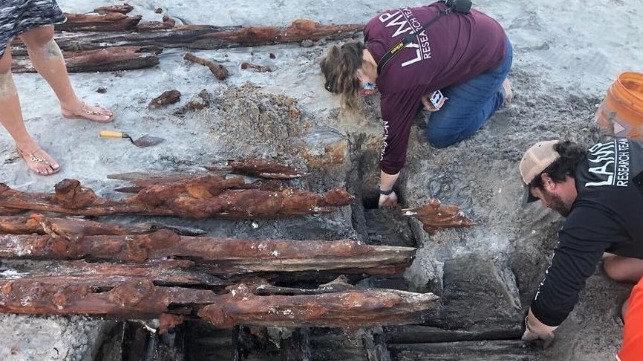1800s-Era Shipwreck Discovered Near Port of St. Augustine

When Tropical Storm Eta passed over Florida earlier this month, it helped to uncover the remains of a wooden shipwreck buried under a dune along Crescent Beach near the port of St. Augustine. The wreck is likely the remains of a merchant ship from the 1800s, according to the St. Augustine Lighthouse Archaeological Maritime Program (LAMP).
A local resident was walking along the beach on Saturday and saw the exposed timbers. Returning on Sunday, he saw more of the timbers uncovered by the waves, and he reached out to LAMP's director, Chuck Meide. The LAMP team began inspecting and documenting the shipwreck on Sunday.
The LAMP team thinks that the ship was likely an American merchant ship carrying basic commodities, like hardware or flour. Over 70 percent of all known historic shipwrecks lost in Florida are merchant vessels that were engaged in coastal trade, moving goods from one port to another along the Atlantic coast. Dating the ship is difficult, but Meide believes it to date back to the 1800s. “Everything we’ve seen on it so far fits that hypothesis - wooden planking, wood timbers, iron fasteners. They look quite similar to other ships from the 1800s that we have seen.”
According to LAMP and the Fort Matanzas National Monument, the wreck could be the remains of the merchant vessel Caroline Eddy. "In late August 1880 the Caroline Eddy left Fernandina bound for New York with a cargo of lumber. She sailed into a hurricane, was driven south and went ashore near Matanzas. Her crew survived after clinging to the rigging for two days and a night," the national monument's staff said in a social media update.

that matters most
Get the latest maritime news delivered to your inbox daily.
As the research arm of the St. Augustine Lighthouse & Maritime Museum, LAMP has helped to identify several shipwrecks over the years. Its team will continue their survey work and take samples of the timbers and iron work from the site. Students from nearby Flagler College will also be working with LAMP to document and record the shipwreck, gaining field experience in archaeology.
“[St. Augustine's] maritime past is America’s story as the nation’s oldest port, dating back to the first Spanish landing in 1565. The St. Augustine Lighthouse Archaeological Maritime Program is committed to saving our maritime history and passing these stories on to our future generations,” said Kathy Fleming, the museum's executive director.
